The Memristive Properties and Spike Timing-Dependent Plasticity in Electrodeposited Copper Tungstates and Molybdates
Abstract
:1. Introduction
2. Materials and Methods
3. Results
3.1. X-ray Diffraction
3.2. X-ray Photoelectron Spectroscopy
3.3. Scanning Electron Microscopy
3.4. Electrical Measurements
3.5. Spike Timing-Dependent Plasticity
4. Discussion
Supplementary Materials
Author Contributions
Funding
Data Availability Statement
Acknowledgments
Conflicts of Interest
References
- Badillo, S.; Banfai, B.; Birzele, F.; Davydov, I.I.; Hutchinson, L.; Kam-Thong, T.; Siebourg-Polster, J.; Steiert, B.; Zhang, J.D. An Introduction to Machine Learning. Clin. Pharmacol. Ther. 2020, 107, 871–885. [Google Scholar] [CrossRef] [PubMed]
- Kish, L.B. End of Moore’s law: Thermal (noise) death of integration in micro and nano electronics. Phys. Lett. A 2002, 305, 144–149. [Google Scholar] [CrossRef]
- Waldrop, M.M. The chips are down for Moore’s law. Nature 2016, 530, 144–147. [Google Scholar] [CrossRef] [PubMed]
- Ielmini, D.; Wong, H.-S.P. In-memory computing with resistive switching devices. Nat. Electron. 2018, 1, 333–343. [Google Scholar] [CrossRef]
- Zhang, W.; Gao, B.; Tang, J.; Yao, P.; Yu, S.; Chang, M.-F.; Yoo, H.-J.; Qian, H.; Wu, H. Neuro-inspired computing chips. Nat. Electron. 2020, 3, 371–382. [Google Scholar] [CrossRef]
- Przyczyna, D.; Lis, M.; Pilarczyk, K.; Szaciłowski, K. Hardware Realization of the Pattern Recognition with an Artificial Neuromorphic Device Exhibiting a Short-Term Memory. Molecules 2019, 24, 2738. [Google Scholar] [CrossRef]
- Di Ventra, M. MemComputing: Fundamentals and Applications; Oxford University Press: Oxford, UK, 2022; ISBN 0192659898. [Google Scholar]
- Serrano-Gotarredona, T.; Masquelier, T.; Prodromakis, T.; Indiveri, G.; Linares-Barranco, B. STDP and STDP variations with memristors for spiking neuromorphic learning systems. Front. Neurosci. 2013, 7, 2. [Google Scholar] [CrossRef]
- Jeong, D.S.; Kim, K.M.; Kim, S.; Choi, B.J.; Hwang, C.S. Memristors for energy-efficient new computing paradigms. Adv. Electron. Mater. 2016, 2, 1600090. [Google Scholar] [CrossRef]
- Chua, L. Memristor-the missing circuit element. IEEE Trans. Circuit Theory 1971, 18, 507–519. [Google Scholar] [CrossRef]
- Strukov, D.B.; Snider, G.S.; Stewart, D.R.; Williams, R.S. The missing memristor found. Nature 2008, 453, 80–83. [Google Scholar] [CrossRef]
- Gao, L.; Ren, Q.; Sun, J.; Han, S.-T.; Zhou, Y. Memristor modeling: Challenges in theories, simulations, and device variability. J. Mater. Chem. C 2021, 9, 16859–16884. [Google Scholar] [CrossRef]
- Chua, L. If it’s pinched it’sa memristor. Semicond. Sci. Technol. 2014, 29, 104001. [Google Scholar] [CrossRef]
- Szot, K.; Rogala, M.; Speier, W.; Klusek, Z.; Besmehn, A.; Waser, R. TiO2—A prototypical memristive material. Nanotechnology 2011, 22, 254001. [Google Scholar] [CrossRef] [PubMed]
- Jo, S.H.; Chang, T.; Ebong, I.; Bhadviya, B.B.; Mazumder, P.; Lu, W. Nanoscale memristor device as synapse in neuromorphic systems. Nano Lett. 2010, 10, 1297–1301. [Google Scholar] [CrossRef] [PubMed]
- Wang, X.; Chen, Y.; Xi, H.; Li, H.; Dimitrov, D. Spintronic memristor through spin-torque-induced magnetization motion. IEEE Electron. Device Lett. 2009, 30, 294–297. [Google Scholar] [CrossRef]
- Hansen, M.; Ziegler, M.; Kolberg, L.; Soni, R.; Dirkmann, S.; Mussenbrock, T.; Kohlstedt, H. A double barrier memristive device. Sci. Rep. 2015, 5, 13753. [Google Scholar] [CrossRef]
- Pan, F.; Gao, S.; Chen, C.; Song, C.; Zeng, F. Recent progress in resistive random access memories: Materials, switching mechanisms, and performance. Mater. Sci. Eng. R Rep. 2014, 83, 1–59. [Google Scholar] [CrossRef]
- Li, Y.; Wang, Z.; Midya, R.; Xia, Q.; Yang, J.J. Review of memristor devices in neuromorphic computing: Materials sciences and device challenges. J. Phys. D Appl. Phys. 2018, 51, 503002. [Google Scholar] [CrossRef]
- Liao, K.; Lei, P.; Tu, M.; Luo, S.; Jiang, T.; Jie, W.; Hao, J. Memristor Based on Inorganic and Organic Two-Dimensional Materials: Mechanisms, Performance, and Synaptic Applications. ACS Appl. Mater. Interfaces 2021, 13, 32606–32623. [Google Scholar] [CrossRef]
- Xu, W.; Wang, J.; Yan, X. Advances in memristor-based neural networks. Front. Nanotechnol. 2021, 3, 645995. [Google Scholar] [CrossRef]
- Yang, X.; Taylor, B.; Wu, A.; Chen, Y.; Chua, L.O. Research progress on memristor: From synapses to computing systems. IEEE Trans. Circuits Syst. I Regul. Pap. 2022, 69, 1845–1857. [Google Scholar] [CrossRef]
- Di Ventra, M.; Pershin, Y. V Memristors and Memelements: Mathematics, Physics and Fiction; Springer Nature: Berlin/Heidelberg, Germany, 2023; ISBN 3031256255. [Google Scholar]
- Babacan, Y.; Yesil, A.; Tozlu, O.F.; Kacar, F. Investigation of STDP mechanisms for memristor circuits. AEU-Int. J. Electron. Commun. 2022, 151, 154230. [Google Scholar] [CrossRef]
- Löwel, S.; Singer, W. Selection of Intrinsic Horizontal Connections in the Visual Cortex by Correlated Neuronal Activity. Science 1992, 255, 209–212. [Google Scholar] [CrossRef]
- Caporale, N.; Dan, Y. Spike Timing–Dependent Plasticity: A Hebbian Learning Rule. Annu. Rev. Neurosci. 2008, 31, 25–46. [Google Scholar] [CrossRef] [PubMed]
- Paulsen, O.; Sejnowski, T.J. Natural patterns of activity and long-term synaptic plasticity. Curr. Opin. Neurobiol. 2000, 10, 172–180. [Google Scholar] [CrossRef]
- Sejnowski, T.J. The book of Hebb. Neuron 1999, 24, 773–776. [Google Scholar] [CrossRef]
- Sun, B.; Jia, X.J.; Wu, J.H.; Chen, P. Photo-electron double regulated resistive switching memory behaviors of Ag/CuWO4/FTO device. Solid State Commun. 2015, 223, 1–5. [Google Scholar] [CrossRef]
- Raizada, P.; Sharma, S.; Kumar, A.; Singh, P.; Parwaz Khan, A.A.; Asiri, A.M. Performance improvement strategies of CuWO4 photocatalyst for hydrogen generation and pollutant degradation. J. Environ. Chem. Eng. 2020, 8, 104230. [Google Scholar] [CrossRef]
- Mikhailik, V.B.; Kraus, H.; Miller, G.; Mykhaylyk, M.S.; Wahl, D. Luminescence of CaWO4, CaMoO4, and ZnWO4 scintillating crystals under different excitations. J. Appl. Phys. 2005, 97, 083523. [Google Scholar] [CrossRef]
- Millers, D.; Grigorjeva, L.; Chernov, S.; Popov, A.; Lecoq, P.; Auffray, E. The Temperature Dependence of Scintillation Parameters in PbWO4 Crystals. Phys. Status Solidi 1997, 203, 585–589. [Google Scholar] [CrossRef]
- Hill, J.C.; Ping, Y.; Galli, G.A.; Choi, K.-S. Synthesis, photoelectrochemical properties, and first principles study of n-type CuW1−xMoxO4 electrodes showing enhanced visible light absorption. Energy Environ. Sci. 2013, 6, 2440–2446. [Google Scholar] [CrossRef]
- Iyengar, P.; Das, C.; Balasubramaniam, K.R. Photoelectrochemical performance of NiO-coated ZnO–CdS core-shell photoanode. J. Phys. D Appl. Phys. 2017, 50, 10LT01. [Google Scholar] [CrossRef]
- Baltrusaitis, J.; Mendoza-Sanchez, B.; Fernandez, V.; Veenstra, R.; Dukstiene, N.; Roberts, A.; Fairley, N. Generalized molybdenum oxide surface chemical state XPS determination via informed amorphous sample model. Appl. Surf. Sci. 2015, 326, 151–161. [Google Scholar] [CrossRef]
- Wagner, A.D.; Naumkin, A.V.; Kraut-Vass, A.; Allison, J.W.; Powell, C.J.; Rumble, J.R.J. NIST Standard Reference Database 20. Available online: http:/srdata.nist.gov/xps/ (accessed on 13 December 2022).
- Biesinger, M.C. Advanced analysis of copper X-ray photoelectron spectra. Surf. Interface Anal. 2017, 49, 1325–1334. [Google Scholar] [CrossRef]
- Biesinger, M.C.; Payne, B.P.; Grosvenor, A.P.; Lau, L.W.M.; Gerson, A.R.; Smart, R.S.C. Resolving surface chemical states in XPS analysis of first row transition metals, oxides and hydroxides: Cr, Mn, Fe, Co and Ni. Appl. Surf. Sci. 2011, 257, 2717–2730. [Google Scholar] [CrossRef]
- Hantsche, H. High resolution XPS of organic polymers, the scienta ESCA300 database. By G. Beamson and D. Briggs, Wiley, Chichester 1992, 295 pp., hardcover, £ 65.00, ISBN 0-471-93592-1. Adv. Mater. 1993, 5, 778. [Google Scholar] [CrossRef]
- Gupta, V.; Kapur, S.; Saurabh, S.; Grover, A. Resistive Random Access Memory: A Review of Device Challenges. IETE Tech. Rev. 2020, 37, 377–390. [Google Scholar] [CrossRef]
- Klein, S.; Weitzel, H. PERNOD—Ein Programm zur Verfeinerung von Kristallstrukturparametern aus Neutronenbeugungspulverdiagrammen. J. Appl. Crystallogr. 1975, 8, 54–59. [Google Scholar] [CrossRef]
- Reichelt, W.; Steiner, U.; Söhnel, T.; Oeckler, O.; Duppel, V.; Kienle, L. Mischkristallbildung im System Cu3Mo2O9/Zn3Mo2O9. Zeitschrift Anorg. Allg. Chem. 2005, 631, 596–603. [Google Scholar] [CrossRef]
- Kwolek, P.; Pilarczyk, K.; Tokarski, T.; Lewandowska, K.; Szaciłowski, K. BixLa1−xVO4 solid solutions: Tuning of electronic properties via stoichiometry modifications. Nanoscale 2014, 6, 2244–2254. [Google Scholar] [CrossRef]

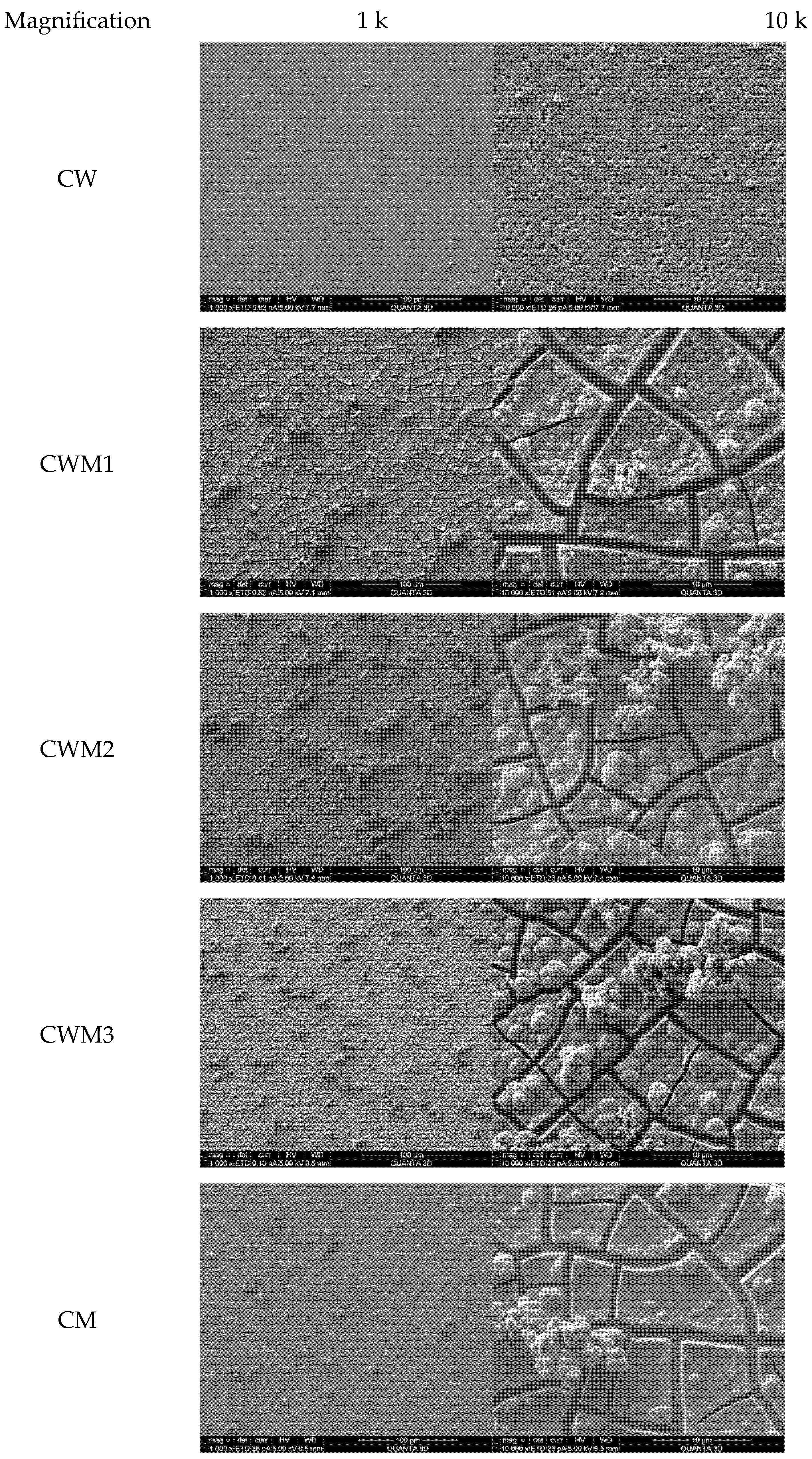
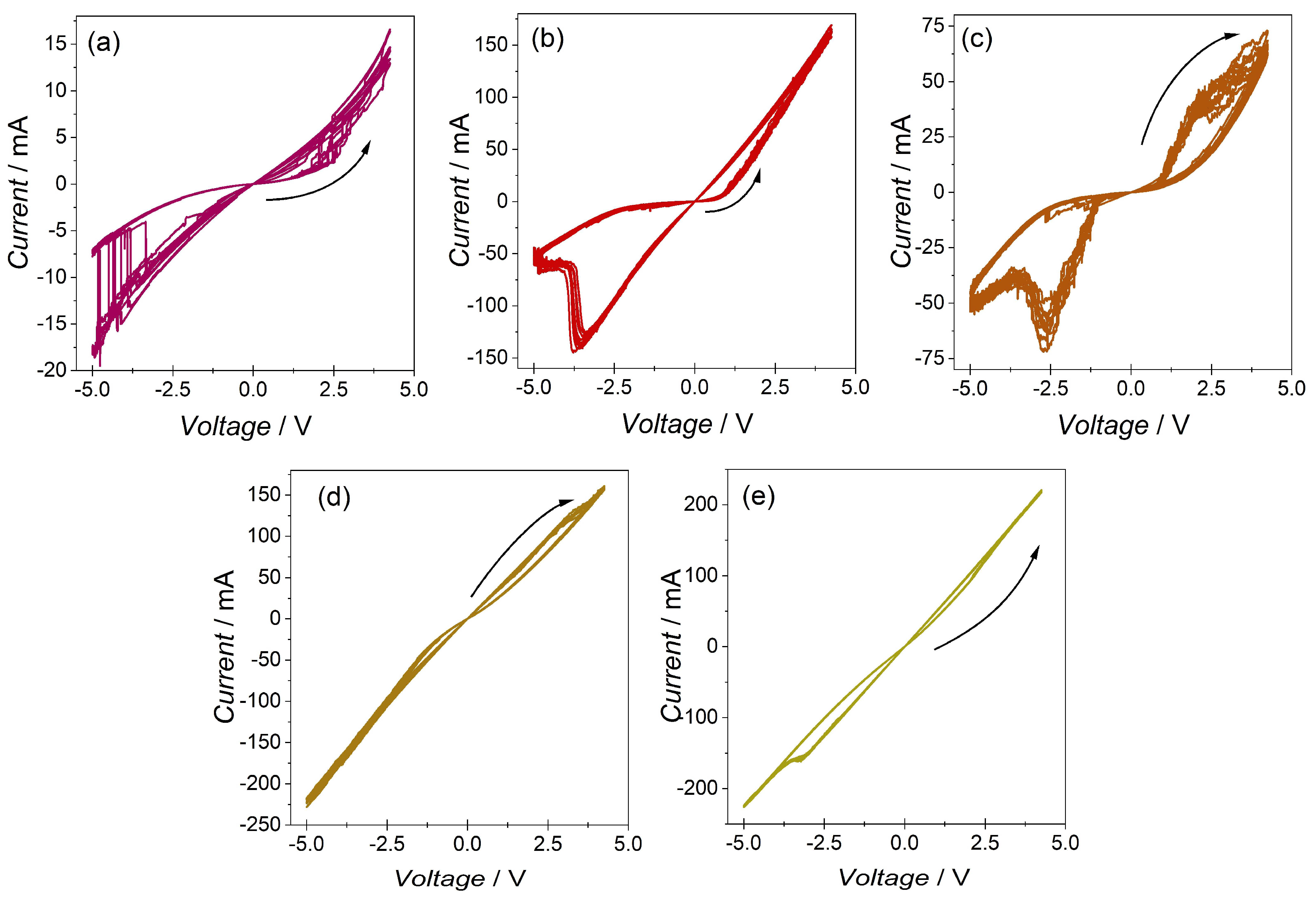
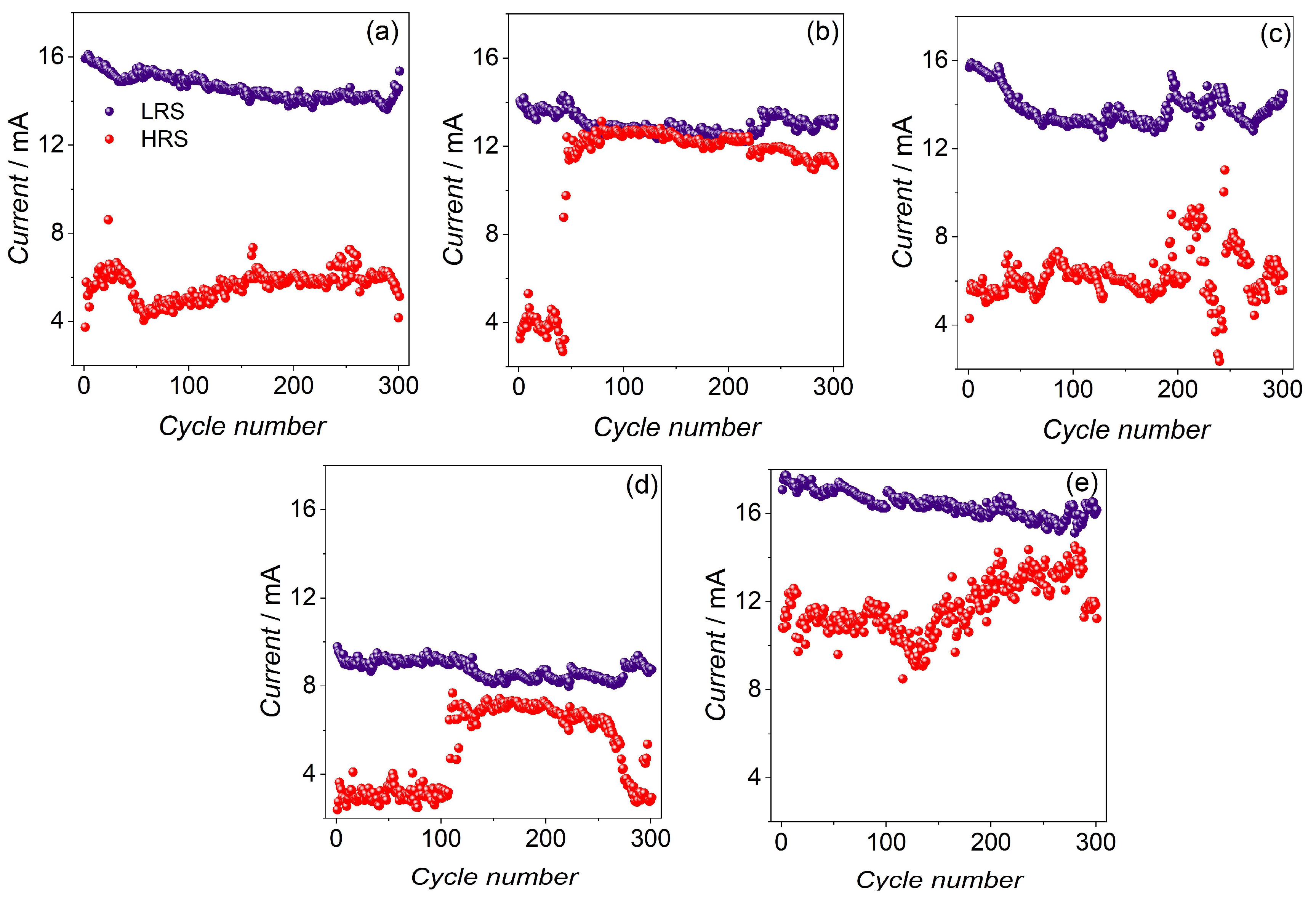
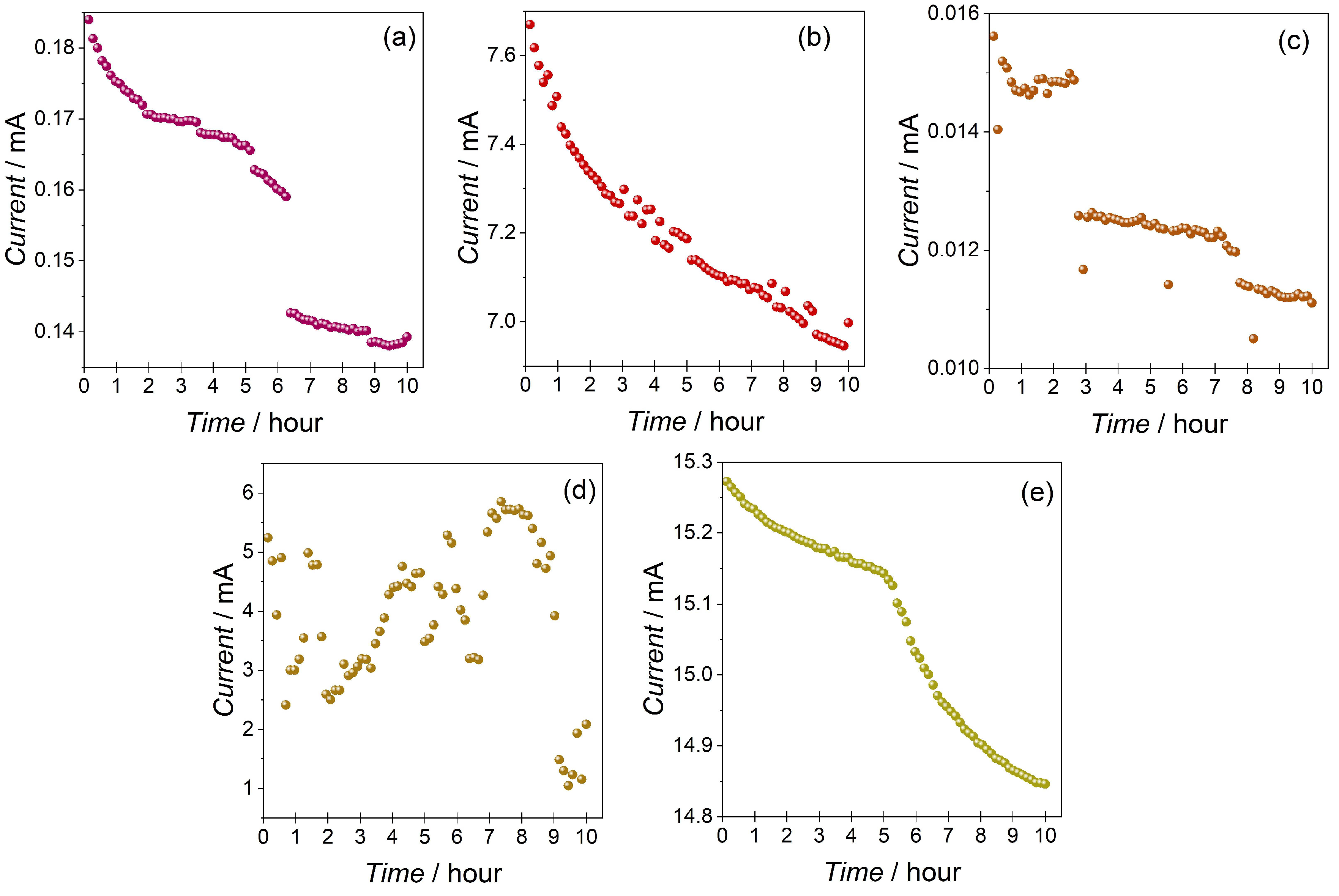
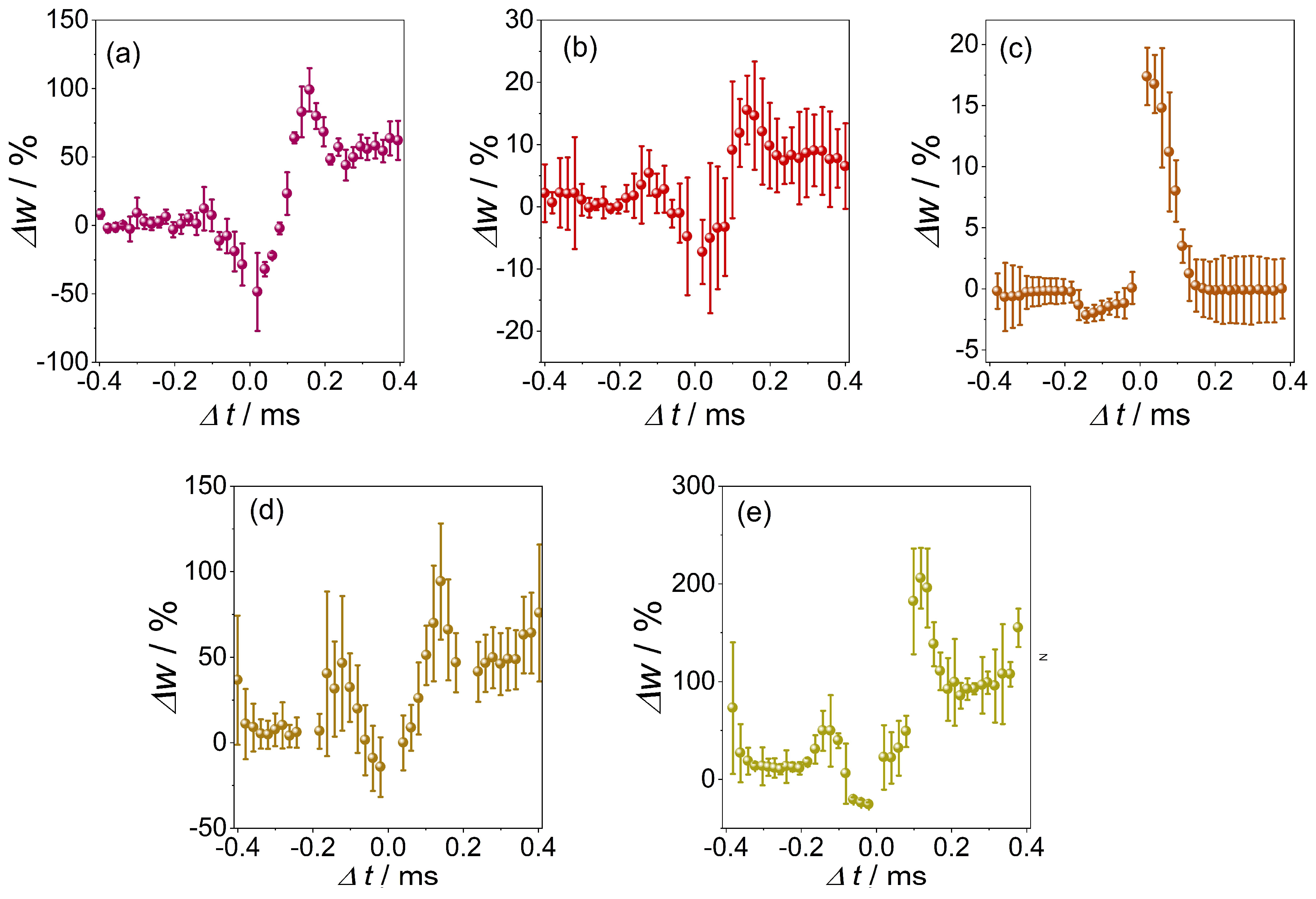

| Sample | Composition of Electrolyte | Composition in Film | |
|---|---|---|---|
| Na2WO4 (mM) | Na2MoO4 (mM) | (W:M Atomic Ratio) | |
| CW | 40 | 0 | 1.00:0.00 |
| CWM1 | 30 | 10 | 0.52:0.48 |
| CWM2 | 20 | 20 | 0.36:0.64 |
| CWM3 | 10 | 30 | 0.20:0.80 |
| CM | 0 | 40 | 0.00:1.00 |
| Peak | C1s.cf1 | C1s.cf2 | C1s.cf3 | O1s.cf1 | O1s.cf2 | O1s.cf3 |
|---|---|---|---|---|---|---|
| Energy [eV] | 285.0 | 286.3 | 288.7 | 530.2 | 531.5 | 532.8 |
| Groups | C-C | C-O | C=O, O-C=O | MeOx (Crystalline) | MeOx (def.) O=C | O-C-OH |
| CW | 13.2 | 2.6 | 0.8 | 48.6 | 6.6 | 1.6 |
| CWM1 | 11.5 | 2.6 | 0.6 | 49.4 | 5.8 | 1.5 |
| CWM2 | 12.5 | 2.0 | 0.8 | 47.0 | 8.0 | 1.6 |
| CWM3 | 12.4 | 3.2 | 0.4 | 48.9 | 6.7 | 1.8 |
| CM | 16.8 | 2.3 | 1.5 | 46.2 | 4.6 | 1.4 |
| Peak | Na1s.cf1 | Cu2p3.cf1 | Cu2p3.cf2 | Cu2+ | Mo3d.cf1 | W4f.cf1 |
|---|---|---|---|---|---|---|
| Energy (eV) | 1071.2 | 931.6 | 932.7 | 934.3 | 232.1 | 35.2 |
| Oxidation States | Na+ | Cu0 | Cu+ | Cu2+ | Mo6+ | W6+ |
| CW | 1.7 | 1.9 | 0.0 | 6.5 | 0.0 | 16.4 |
| CWM1 | 1.9 | 4.3 | 2.0 | 4.9 | 7.0 | 8.6 |
| CWM2 | 2.4 | 2.6 | 0.7 | 6.8 | 9.5 | 6.2 |
| CWM3 | 2.1 | 2.0 | 0.7 | 6.4 | 11.9 | 3.4 |
| CM | 1.7 | 2.3 | 1.5 | 6.7 | 14.8 | 0.0 |
| Sample | dlayer (nm) a | delectrode (nm) b | R (kΩ) | σ (Ω·m) |
|---|---|---|---|---|
| CW | 630 ± 50 | 50 ± 7 | 464.0 ± 0.1 | 3682.8 ± 0.2 |
| CWM1 | 1000 ± 50 | 63 ± 7 | 43.3 ± 0.1 | 216.7 ± 0.2 |
| CWM2 | 1600 ± 50 | 57 ± 7 | 92.9 ± 0.1 | 290.2 ± 0.2 |
| CWM3 | 1300 ± 50 | 80 ± 7 | 24.9 ± 0.1 | 95.9 ± 0.2 |
| CM | 1320 ± 50 | 53 ± 7 | 21.3 ± 0.1 | 80.7 ± 0.2 |
Disclaimer/Publisher’s Note: The statements, opinions and data contained in all publications are solely those of the individual author(s) and contributor(s) and not of MDPI and/or the editor(s). MDPI and/or the editor(s) disclaim responsibility for any injury to people or property resulting from any ideas, methods, instructions or products referred to in the content. |
© 2023 by the authors. Licensee MDPI, Basel, Switzerland. This article is an open access article distributed under the terms and conditions of the Creative Commons Attribution (CC BY) license (https://creativecommons.org/licenses/by/4.0/).
Share and Cite
Przyczyna, D.; Mech, K.; Kowalewska, E.; Marzec, M.; Mazur, T.; Zawal, P.; Szaciłowski, K. The Memristive Properties and Spike Timing-Dependent Plasticity in Electrodeposited Copper Tungstates and Molybdates. Materials 2023, 16, 6675. https://doi.org/10.3390/ma16206675
Przyczyna D, Mech K, Kowalewska E, Marzec M, Mazur T, Zawal P, Szaciłowski K. The Memristive Properties and Spike Timing-Dependent Plasticity in Electrodeposited Copper Tungstates and Molybdates. Materials. 2023; 16(20):6675. https://doi.org/10.3390/ma16206675
Chicago/Turabian StylePrzyczyna, Dawid, Krzysztof Mech, Ewelina Kowalewska, Mateusz Marzec, Tomasz Mazur, Piotr Zawal, and Konrad Szaciłowski. 2023. "The Memristive Properties and Spike Timing-Dependent Plasticity in Electrodeposited Copper Tungstates and Molybdates" Materials 16, no. 20: 6675. https://doi.org/10.3390/ma16206675
APA StylePrzyczyna, D., Mech, K., Kowalewska, E., Marzec, M., Mazur, T., Zawal, P., & Szaciłowski, K. (2023). The Memristive Properties and Spike Timing-Dependent Plasticity in Electrodeposited Copper Tungstates and Molybdates. Materials, 16(20), 6675. https://doi.org/10.3390/ma16206675





